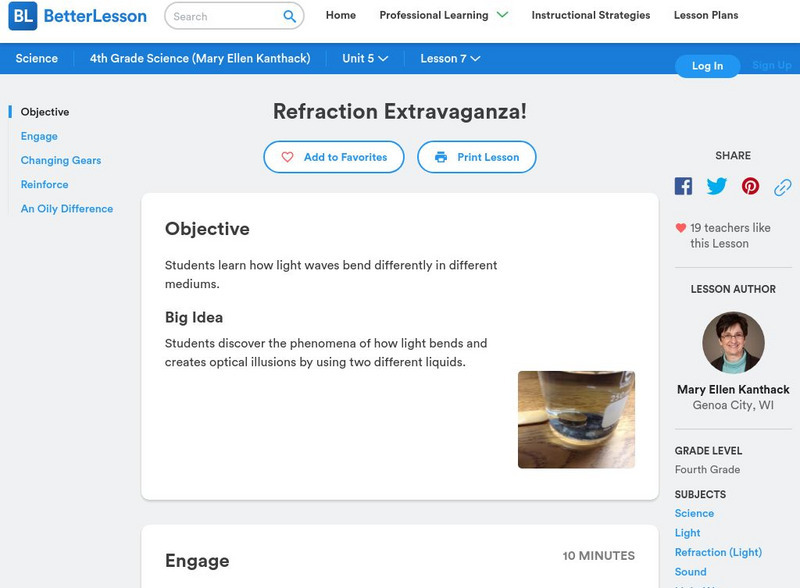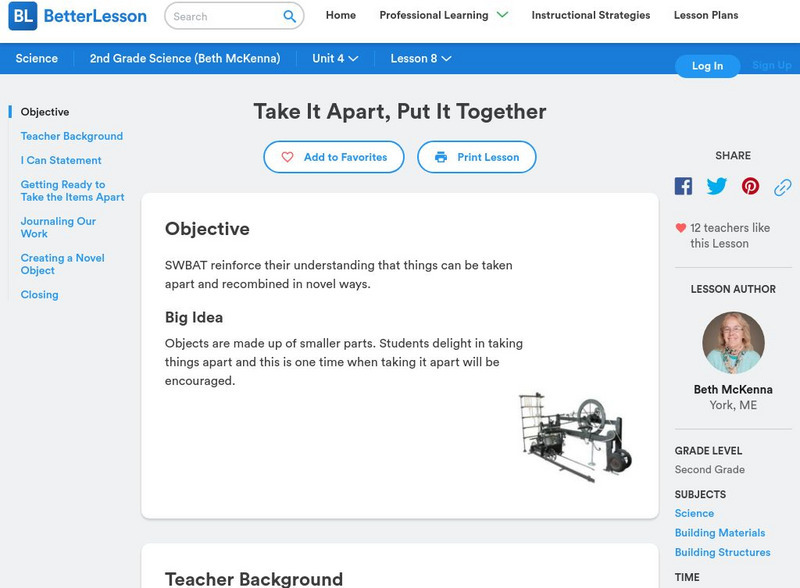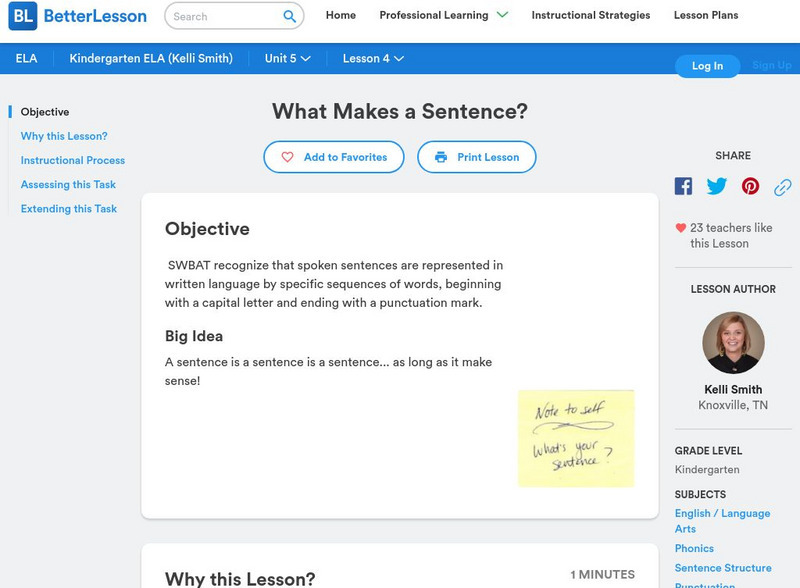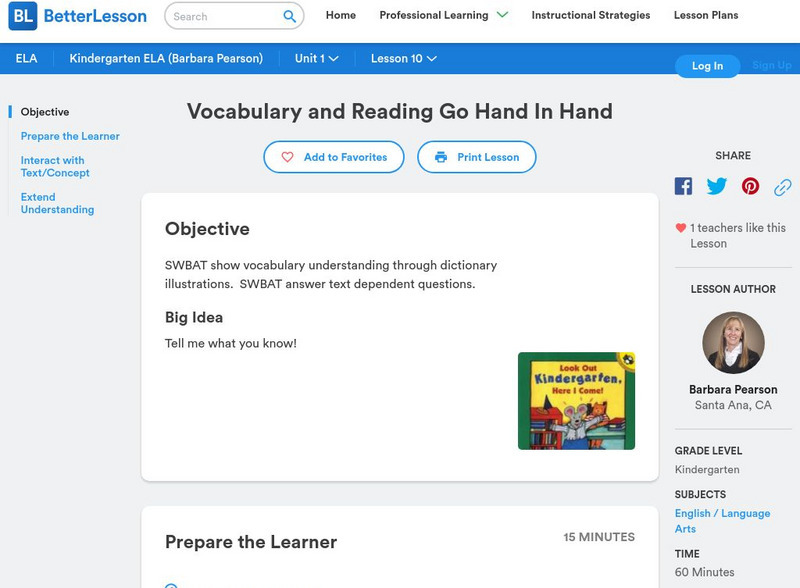Better Lesson
Better Lesson: Water on Earth Liquid or Solid
Climates vary and understanding that water on earth reacts to the climate is a way to understand why water can be found as both liquid and solid on earth. Included in this lesson is a video of the activity in action, and an image of a...
Better Lesson
Better Lesson: Refraction Extravaganza!
Fourth graders learn how light waves bend differently in different mediums.
Better Lesson
Better Lesson: The Lightbulb Just Went On!
Fourth graders discover how electricity can be converted to light energy.
Better Lesson
Better Lesson: Drop and Pop Energy and Speed Exploration
Fourth graders use a toy to make observations that speed is related to the amount of energy in an object as well as work with gravitational and elastic potential energy.
Better Lesson
Better Lesson: Design Solutions Engage, Explore
Third graders illustrate and write out notes for a plan (or several plans) to mitigate the effects of a local weather hazard.
Better Lesson
Better Lesson: Building Things in Different Ways
This lesson poses the question "can you always take something apart and put it together in different ways?". Students will take part in designing an investigation using snap cubes to help figure out an answer. Videos of the lesson in...
Better Lesson
Better Lesson: Take It Apart, Put It Together
The purpose of this lesson is to reinforce the idea that things are made up of small parts that can be recombined in novel ways. It also shows that the shape of certain parts dictates their function. Students delight in taking things...
Better Lesson
Better Lesson: Email Clarifying Questions
At the end of this lesson, students will demonstrate the use of commas, clarifying questions, and a friendly letter format by sending an email. Email is part of student's lives, and it is part of the digital landscape they will need to...
Better Lesson
Better Lesson: What Makes a Sentence?
This lesson will help students recognize that spoken sentences are represented in written language by specific sequences of words, beginning with a capital letter and ending with a punctuation mark. This lesson is short but it allows...
Better Lesson
Better Lesson: Engage in Group Reading Activities With Purpose and Understanding
Choose from a variety of lessons that meet the Kindergarten standard of engaging in group reading activities with purpose and understanding.
Better Lesson
Better Lesson: Vocabulary and Reading Go Hand in Hand
Students will be doing their own illustrations of the vocabulary words from "Look Out Kindergarten, Here I Come!" Students will also practice the skill of sequencing.
Better Lesson
Better Lesson: R E S P E C T
What does it mean to respect someone? How will you show respect to our math community? Students work together to generate expectations for each other and the teacher to ensure that people are respected.
Better Lesson
Better Lesson: Unit Closure
What is going on in the problem? What are you trying to figure out? What kind of model could you create for this problem? Students apply the skills they have learned throughout Unit 4.
Better Lesson
Better Lesson: Unit Review
What number sentence represents what is going on in this problem? Why? What kind of model could you create for this problem? Students review the skills they have learned throughout Unit 4.
Better Lesson
Better Lesson: Strategies for Dividing Fractions Day 2 + Show What You Know
What strategies do you have for dividing fractions? How do you divide 1 2/3 by 1/3? Students apply all that they have learned about dividing with fractions to divide mixed numbers by fractions for a second day.
Better Lesson
Better Lesson: Strategies for Dividing Fractions
What strategies do you have for dividing fractions? How do you divide 1 1/8 by 1/4? Students apply all that they have learned about dividing with fractions to divide mixed numbers by fractions.
Better Lesson
Better Lesson: Dividing Fractions by Fractions
What do you get when you divide 1/4 by 1/2? What does your answer actually mean? Students continue building their skills and strategies in order to divide fractions by fractions.
Better Lesson
Better Lesson: Dividing Whole Numbers by Fractions
What do you get when you divide 6 by 2/3? How can you connect this problem to multiplication? Students continue to make connections between multiplication and division and work to develop strategies for dividing whole numbers by fractions.
Better Lesson
Better Lesson: Basic Fractions on a Number Line (Divisible by Two)
Third graders create number lines to represent benchmark fractions.
Better Lesson
Better Lesson: Units & Wholes (Days 1 3)
It is important for students to learn to compare the size of the same fraction units as the size of the whole amount changes.
Better Lesson
Better Lesson: Connecting Multiplication and Division
How are multiplication and division connected? Why do 11 divided by 2 and 11 times 1/2 result in the same answer? Students make connections between multiplication and division and work to develop strategies for dividing whole numbers by...
Better Lesson
Better Lesson: The Multiplying Game
How can you create the smallest product in the Multiplying Game? Students apply what they know about multiplying fractions to the Multiplying Game.
Better Lesson
Better Lesson: Mixed Number Multiplication
How can we use diagrams to multiply mixed numbers? How can we multiply mixed numbers without using a diagram? Students apply what they know about multiplying fractions to multiplying with mixed numbers.
Better Lesson
Better Lesson: Representing Fraction Multiplication Day 2
What does it mean when you multiply fractions? How can you multiply fractions without drawing a diagram? Students build on their skills for multiplying fractions and they work to develop an algorithm.











